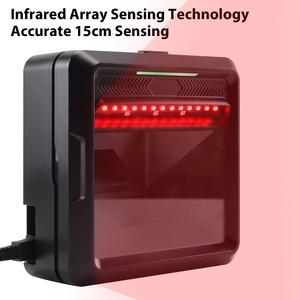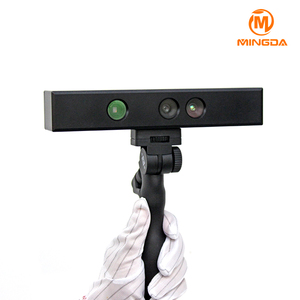Types of scanners for reverse engineering
Scanners for reverse engineering are designed to create digital models of physical objects. These models are used to get more information about the scanned object so that existing designs can be improved. They are also used to create new designs when there are no available blueprints.
There are several kinds of scanners for reverse engineering, which vary according to their working methods:
- Laser scanners: These scanning machines work by emitting a laser beam and capturing the reflected signal with a sensor. The time taken for the laser beam to be reflected back is an indication of the distance covered by the beam. A point cloud of the object is created from the measurements obtained from the laser scan. Point cloud data gives detailed information about an object's shape and size.
- Structured light scanners: Structured light scanning devices project a pattern of light onto an object and record the distortion of the pattern. Distortion gives information about the object's geometry to create a 3D model. These scanners are useful for obtaining detailed information about small parts or areas of an entire object.
- Contact-based scanners: This type of scanner has a probe that physically touches different points on an object's surface. The probe's movement gives accurate physical measurement of the scanned object. As a result, a precise 3D replica of the object is created. Contact scanners are known for providing high accuracy, so they are mostly used to measure up engineering parts with very tight tolerances.
Functions and Features of Scanner for Reverse Engineering
The main function of a reverse engineering scanner is to generate a detailed scaled 3D model from an object that can be accurately measured. This model can then be modified or inspected digitally. Several features of these scanners make them an invaluable tool in engineering and design fields:
- High resolution: Models with precise details can be generated with high-resolution scanning. This is critical for applications that require high accuracy. A high-resolution scanner can produce detailed object structures with small feature recognition.
- Fast scanning speed: The speed at which a scanner can capture its data is critical. Quick scanning reduces the time needed to create the digital model. For instance, some 3D scanners can collect data points up to 1 million per second.
- Large scanning range: The range of size a scanner can cover is better in some models than others. Some scanners can work better than others, depending on their large or small size.
- Multiple data output formats: The various file types in which the scanned data can be exported affect users' ability to work in different software environments. Not all scanners can export the same file types. SCAD, STL, OBJ, and PLY are a few examples of file types that can be exported.
- User-friendly software: Complicated scanning procedures and tough data post-processing require users to have a certain level of expertise. The cost of acquiring special skills can be avoided if a scanner has user-friendly software with simple operating steps and a clear interface.
- Wireless connectivity: A wireless link can connect different devices and peripherals during the scanning process. WiFi, Bluetooth, and NFC are a few examples of wireless technology that can be used to enhance the scanning procedure.
- Robust structure: Handheld scanners need to be tough and resilient to endure rough use in outdoor settings. Good reverse engineering scanners should have long-lasting and resilient features.
- Battery life: Portable scanners need to have a good battery life to enable long-lasting and uninterrupted scanning sessions.
Scenarios
Scanners are very important in reverse engineering. They help people take apart working models of things so they can really look at the pieces and how everything fits together. This aids in creating new or better versions of these items. Several applications of a scanner for reverse engineering include the following:
- Improving Machines: Factories use scanners to get detailed 3D plans of production line machines. This assists them with understanding how the machines work, finding issues, and further developing assembling processes. By dissecting the 3D models got from the sweep, they can decide any maintenance needs and upgrade the machine's execution.
- Examining Competitors' Products: Businesses that make new items frequently utilize planners to make new thoughts and plans by taking a gander at the 3D models the scanner makes of rival items. These scans allow companies to see how different parts work together and inspire the development of new and better products.
- Restoring Old Machines: Restoration experts use reverse engineering to maintain historical artifacts. They can replicate absent or broken components from outdated machines and gadgets by utilizing scanners to acquire 3D specs of these articles. This guarantees that these old items can be kept running for a long time to come.
- Sculpting and Designing: Artists and designers often use reverse engineering to create unique works of art or pieces of fashion. They can scan existing objects to obtain detailed specifications and then modify them to fit their individual styles and creative visions.
- Medical Applications: The healthcare system uses reverse engineering to help make new gadgets that guide in fixing the human body, similar to machines that assist with breathing and hearts. Additionally, scientists employ reverse engineering to learn more about medications and how they function in the body so that they can design new treatments.
- Education and Training: Reverse engineering using scanners is an important part of education and learning. Schools and job training programs use it to help people understand how things work in different fields, like building computers, working with robots, or using science to see if liquids really mix together the way they are supposed to.
How to Choose Scanner for Reverse Engineering
When purchasing a scanner for reverse engineering, it is vital to consider factors that will meet specific demands. They include;
- Type of scanners: Consider the kind of engineering scanner that fits a particular application. A laser scanner is ideal for precise and high-quality 3D data collection over a large area. Handheld scanners, on the other hand, are portable and versatile, thus suitable for complex or small object scanning. Structured light scanners work best in controlled environments and are perfect for objects with good surface details and neutral lighting conditions.
- Accuracy and Resolution: When choosing a scanner for reverse engineering, it is crucial to consider the accuracy and resolution. High accuracy is important for fit and function, while high resolution is ideal for detailed geometry extraction. These two factor needs might differ based on the end application.
- Speed and Performance: The scanning speed needs to be high enough to reduce the time of data collection, while the processing power should quickly handle point cloud data for efficient performance.
- Compatibility Software: The scanner needs to come with user-friendly software for effective data processing, including filtering, cleanup, and meshing.
- Budget: When purchasing an engineering scanner, it is important to consider its budget. That's why buyers should strive to get the best value for the money spent on the scanner. This can be achieved by balancing cost against features and performance without compromising quality.
- Support and Community: Suppliers that offer excellent after-sale support should be considered. Also, the availability of active users' communities is a big boost in troubleshooting.
- Type of objects: Consider the kind of object to be scanned to determine whether the scanner is portable or fixed.
Q&A
Q: How does a scanner for reverse engineering work?
A: Scanners for reverse engineering create a digital model of an item. First, they precisely scan the external shape of the item. Then, they may test the function of each part. After that, they use computer software to check the 3D model and ensure it is correct. This process gives a complete digital copy of the item so that it can be examined and improved.
Q: What is the benefit of using a reverse engineering scan?
A: Using a scan for reverse engineering has many benefits. It makes duplicates of hard-to-get quality items, allowing testing and examination of every part. The detailed 3D models provide clear information to learn about the design choices made. It also helps find and fix design mistakes in new items.
Q: How does one choose a scanner for reverse engineering?
A: Choosing the right scanner for reverse engineering is very important. It is good to consider the features of the scanner, such as accuracy, speed, and software tools. These qualities can greatly affect the quality of the finished digital model. It is also necessary to know the type of scanner being purchased, whether it is a laser or an optical scanner. Also, consider the size of the objects that the scanner can scan.


















































































































































































